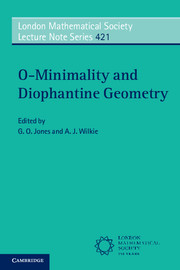Book contents
- Frontmatter
- Contents
- Preface
- 1 The Manin-Mumford Conjecture, an elliptic Curve, its Torsion Points & their Galois Orbits
- 2 Rational points on definable sets
- 3 Functional transcendence via o-minimality
- 4 Introduction to abelian varieties and the Ax–Lindemann–Weierstrass theorem
- 5 The André-Oort conjecture via o-minimality
- 6 Lectures on elimination theory for semialgebraic and subanalytic sets
- 7 Relative Manin-Mumford for abelian varieties
- 8 Improving the bound in the Pila-Wilkie theorem for curves
- 9 Ax-Schanuel and o-minimality
7 - Relative Manin-Mumford for abelian varieties
Published online by Cambridge University Press: 05 August 2015
- Frontmatter
- Contents
- Preface
- 1 The Manin-Mumford Conjecture, an elliptic Curve, its Torsion Points & their Galois Orbits
- 2 Rational points on definable sets
- 3 Functional transcendence via o-minimality
- 4 Introduction to abelian varieties and the Ax–Lindemann–Weierstrass theorem
- 5 The André-Oort conjecture via o-minimality
- 6 Lectures on elimination theory for semialgebraic and subanalytic sets
- 7 Relative Manin-Mumford for abelian varieties
- 8 Improving the bound in the Pila-Wilkie theorem for curves
- 9 Ax-Schanuel and o-minimality
Summary
Abstract
With an eye or two towards applications to Pell's equation and to Daven-port's work on integration of algebraic functions, Umberto Zannier and I have recently characterized torsion points on a fixed algebraic curve in a fixed abelian scheme of dimension bigger than one (when all is defined over the algebraic numbers): there are at most finitely many points provided the natural obstacles are absent. I sketch the proof as well as the applications.
A very simple problem of Manin-Mumford type is: find all roots of unity ƛ, μ with ƛ + μ = 1. Here the solution is easy: we have |ƛ| = |1 − ƛ| = 1 and so in the complex plane ƛ lies on the intersection of two circles; in fact ƛ must be one of the two primitive sixth roots of unity (the picture doesn't work too well in positive characteristic, and indeed any non-zero element of any finite field is already a root of unity, so from now on we stick to zero characteristic). This result has something to do with the multiplicative group Gm, which can be regarded as C*. Actually with and the “line” inside it parametrized by P = (ƛ, 1 − ƛ): we ask just that P is torsion.
Now it is easy to generalize, at least the problem, to other algebraic varieties in other commutative algebraic groups.
For example let E be the elliptic curve defined by y2 = x(x − 1)(x − 4). Asking for all complex ƛ such that the points
are both torsion amounts to asking for torsion points on a certain curve in the surface E2. But here the solution is much more difficult (and it is not clear to me that one can find all ƛ explicitly as above).
It was Hindry [H] who solved the general problem with any algebraic variety in any commutative algebraic group G. The outcome for a curve in G is that it contains at most finitely many torsion points unless one of its components is a connected one-dimensional “torsion coset”; that is, a translate P0 + H of an algebraic subgroup H of G by a torsion point P0. This H contains infinitely many torsion points and so P0 + H also.
- Type
- Chapter
- Information
- O-Minimality and Diophantine Geometry , pp. 193 - 203Publisher: Cambridge University PressPrint publication year: 2015



